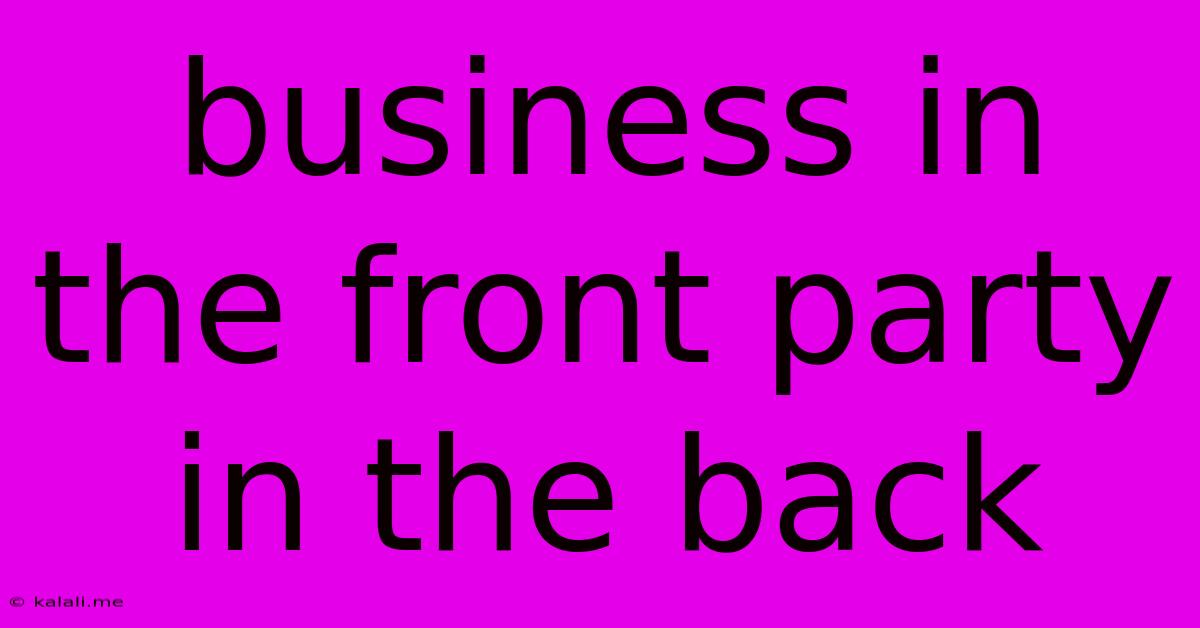Business In The Front Party In The Back
Kalali
May 23, 2025 · 3 min read

Table of Contents
Business in the Front, Party in the Back: Mastering the Art of Dual Branding
The "business in the front, party in the back" mullet hairstyle, once a symbol of the 80s, has found a new life as a powerful metaphor in the world of branding. This article explores the concept of dual branding – presenting two distinct but complementary faces to different target audiences – and how businesses can leverage this strategy for success. Learn how to cultivate a professional image while simultaneously engaging a more playful, less formal side, all within a cohesive brand strategy.
What is Dual Branding?
Dual branding, or multi-faceted branding, involves crafting two separate brand identities within a single business. This isn't about deception; instead, it's about strategically tailoring your message to resonate with specific customer segments. Imagine a sophisticated financial advisor who also hosts a popular, informal podcast about personal finance. The advisor maintains a professional, trustworthy persona for clients, while the podcast allows them to connect with a broader audience in a more relatable and engaging way. This duality amplifies reach and brand loyalty.
Identifying Your Two Sides:
The first step in implementing a "business in the front, party in the back" branding approach is to clearly define your two target audiences.
- The "Business" Side: Identify your core audience – those who need a professional, reliable, and potentially high-end product or service. What is their demographic? What are their values? What language resonates with them?
- The "Party" Side: This is where you can let your brand's personality shine. Who is your secondary audience? Consider a younger demographic, a more casual market, or those seeking a less formal connection with your brand. How can you reach them authentically?
Key Elements of a Successful Dual Branding Strategy:
- Consistent Core Values: While the presentation may differ, the underlying values of your brand should remain consistent across both personas. This ensures brand unity and prevents audience confusion.
- Strategic Communication: Use distinct visual elements, messaging styles, and even platform choices for each side of your brand. A professional LinkedIn presence might be complemented by a fun, engaging Instagram account.
- Clear Brand Segmentation: Avoid blurring the lines between your two personas. Maintain distinct identities to avoid diluting your message or confusing your target audiences.
- Integrated Marketing: Even though your marketing efforts will be segmented, ensure there are subtle cross-promotional opportunities. A mention of your podcast on your professional website or a link to your professional services on your podcast's show notes can create synergistic growth.
- Data-Driven Approach: Track the performance of each brand identity. Analyze which marketing strategies are most effective for each audience to optimize your campaigns and allocate resources strategically.
Examples of Dual Branding in Action:
While not explicitly a "business in the front, party in the back" approach, many successful brands utilize similar principles:
- High-end fashion brands often maintain a sophisticated, high-fashion image while simultaneously releasing more accessible, trend-driven lines.
- Musicians often present a polished stage persona while cultivating a more casual, relatable image off-stage through social media or interviews.
- Tech companies may release professional software for enterprise clients while simultaneously offering consumer-friendly applications or games.
Conclusion:
Mastering the art of dual branding requires a strategic approach and a deep understanding of your target audiences. By crafting distinct but complementary brand identities, you can expand your reach, increase brand awareness, and ultimately drive business growth. Remember to maintain a consistent core message while allowing your brand's personality to shine in different contexts. This balanced approach allows you to be both professional and approachable, effectively appealing to a wider spectrum of potential customers.
Latest Posts
Latest Posts
-
How Do You Cut Flexible Conduit
May 23, 2025
-
Caught 10 Mice How Many More
May 23, 2025
-
How Many Times Is Jesus Mentioned In Quran
May 23, 2025
-
What Happens If You Drive With Parking Brake On
May 23, 2025
-
Unbounded Function Is Not Riemann Integrable
May 23, 2025
Related Post
Thank you for visiting our website which covers about Business In The Front Party In The Back . We hope the information provided has been useful to you. Feel free to contact us if you have any questions or need further assistance. See you next time and don't miss to bookmark.